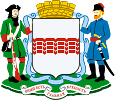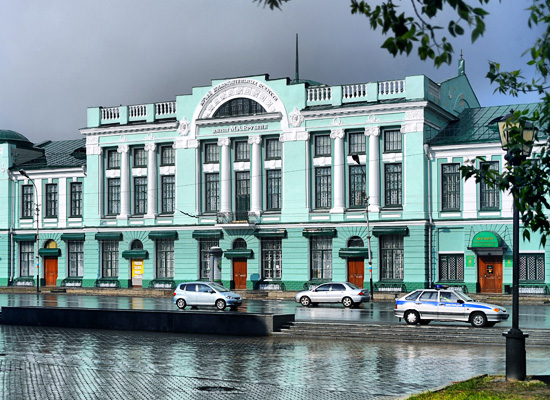The citizens of Omsk are proud of the Vrubel Museum of Fine Arts established in 1924. Its collection contains over 25,000 items, the most part of which is of global importance: outstanding paintings of Russian and European artists, sculptures, the graphic arts, prints, rare print publications, furniture, rich bronze collection, creations of famous Carl Faberge and items of Russian, French, Sachs and Chinese porcelain factures. The exposition possesses one of the best collection of paintings by prominent Russian artists as Vrubel, Venetsianov, Levitan, Makovsky, Kramskoi, Borisov-Musatov, Vereschagin, Konchalovsky, Kandinsky, Benua, Korovin, Polenov, Repin, Roerich, Serov and Surikov.
The museum exposition occupies two buildings. The first one is a former Trade Corpus built upon the project of architect Kryachkov in 1914, and the second one is a former Governor-General Palace, built on the left bank of the river Om’ upon the project of architect Wagner in 1859–1862.
©Photo by Andrey Kudryavtsev
Omsk State Museum of Fine Arts. Main building
The Governor-General Palace is one of the most interesting monuments in Omsk history and architecture. It was built on the site of the Ambassadorial residence for the Asian embassy, which had burned down in 1823.
The house is a two-story brick-built mansion of Russian classic style. One might also see some elements of Renaissance architecture. Unlike any other Omsk building of the second half of the 19th century, the Palace has preserved its external architectural character.
©Photo courtesy of Omsk State Museum of Fine Arts named after M. Vrubel
Omsk State Museum of Fine Arts. Governor-General Palace
House-Museum of Kondratiy Belov is located in one of the most beautiful buildings of wooden architecture of the early 20th century (10 Tch. Valikhanov Street). Kondratiy Belov is a well-known classic in the field of landscape painting.
©Photo by Vladimir Safonov
House-Museum of Kondratiy Belov
In the center of the exposition there are portrait-paintings created in the tradition of the realistic school as well as Omsk historical paintings. The artist’s studio has been reconstructed in one of the rooms. The visitors can see family photos on the walls; popular books on the bookshelves; coat, hat, and cane of Kondratiy Belov on the hanger; an unfinished painting of the artist still standing on the easel. Traditionally, all excursions are being concluded with some tea-drinking with Siberian pies. During this tea-drinking visitors have the opportunity to share their opinions and impressions about the exhibition. On Saturdays the museum organizes Russian romance concerts.
The house of the Omsk fortress commandant can be counted among the oldest buildings of the city. It was built in the 18th century. The commandant’s office was located in this building, and the commandant’s family lived here as well. There are some documents proving that the writer Fyodor Dostoevsky, who had been in Omsk prison since January of 1850, visited the last commandant of the fortress A. Grave. It was Omsk prison where the world-view of the great Russian writer was formed; all his novels recall memories about the hard days spent in prison.
©Photo courtesy of Omsk State Literary Museum named after Fyodor Dostoevsky
Omsk State Literary Museum named after Fyodor Dostoevsky
In 1983 Dostoevsky Literary Museum was opened in this building. Its exposition features a history of the creation and development of literary traditions in Western Siberia since the 18th century. The major part of the exposition is devoted to the life and works of Fyodor Dostoevsky.
©Photo courtesy of Omsk State Literary Museum named after Fyodor Dostoevsky
Monument to Fyodor Dostoevsky. Sculptor Sergey Golovantsev, architect Albert Karimov





